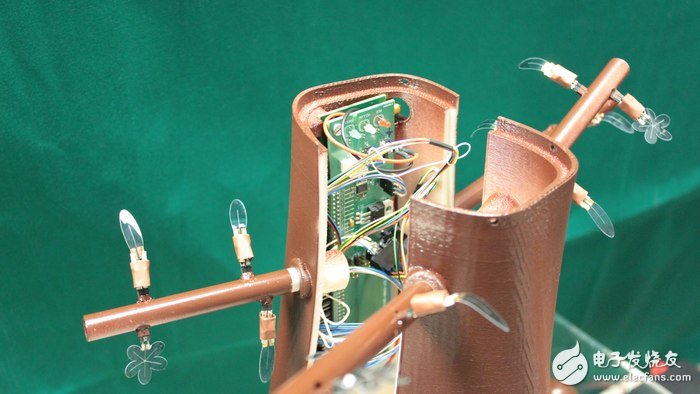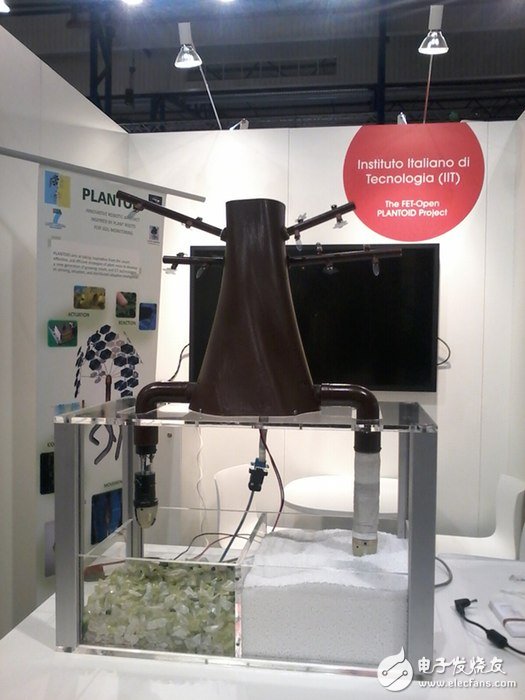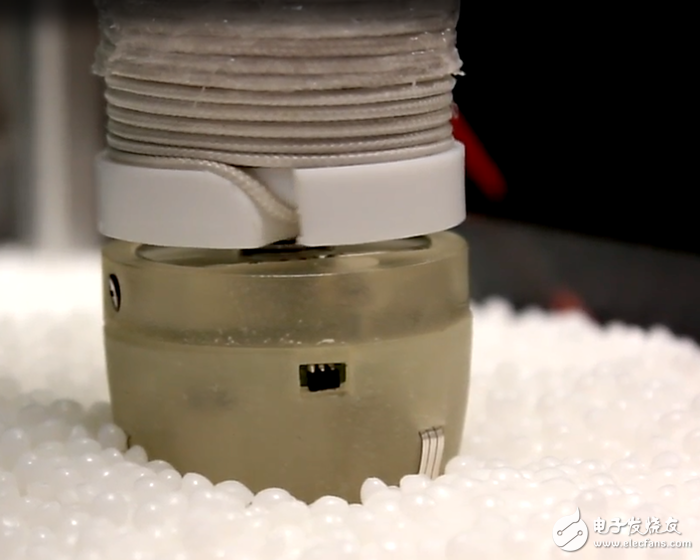European scienTIsts developing a roboTIc tree

The PLANTOID robot, with its "trunk" and sensor/leaf-bearing branches
Image Gallery (4 images)
The animal kingdom contains many examples of efficient forms of locomoTIon, so it's no wonder that we've been seeing a lot of animal-inspired robots – recent examples have included a roboTIc cheetah, fish and snake. Plants, however, just sit there . .. don't they? Actually, they do move, just not in a Point A to Point B manner. With that in mind, Europe's PLANTOID project consortium is now in the process of developing a tree-like robot. Bamboo find use in the exploration of other planets.
The base of the PLANTOID robot is a 3D-printed plastic "trunk," which houses a microprocessor. Extending out from the sides of that trunk are four plastic branches, the leaves of which are actually sensors capable of detecting and measuring factors such as temperature , humidity, gravity, touch, and chemical elements.
The robot's two roots, however, are where the real action is.

The robot on display, showing its tentacle-like and "growing" roots (bottom left and right, respectively)
One of those roots, which bends like a tentacle, has a tactile-sensor-equipped tip. Using that sensor, as it squirms its way through the dirt, the root can change direction when it encounters solid obstacles ... much like a natural Root does. It could also be equipped to sense and avoid toxic substances in the ground.
The other root (seen below) is actually able to grow down into the substrate. It has a rotating tip, which extrudes a coiled cord behind it as it turns. The coils join together to form a tube-like root, which continues to grow As long as the tip keeps turning.

In its present form, the PLANTOID robot serves mainly as a proof-of-concept model. Down the road, however, the technology developed for its roots could lead to better endoscopic surgical tools, or for tools used in locating victims buried in debris at disaster sites.
Complete PLANTOID-type robots could be used to monitor things like soil conditions and pollutant levels here on Earth, or they could even find use gathering environmental data on other planets. Once deposited by an unmanned rover, a PLANTOID could secure itself in place via Its roots, then set about sensing the air and soil.
The project is being led by the Istituto Italia di Tecnologia, with the other members consisting of the Institute for Bioengineering of Catalonia (Spain), the Università degli Studi di Firenze (Italy) and EPFL (Switzerland). It began in 2012, and is Due to wrap up next April. In the meantime, the researchers are looking into adding other functions to the roots, and devising ways in which the robots could draw power from their environment.
Sources: CORDIS, PLANTOID
Automatic translation is for reference only
European scientists develop bionic tree robots

European scientists develop a robot tree
PLANTOID robot, its "trunk" and sensor
Leaf bearing branch
Image gallery (4 images)
Effective form of the animal kingdom contains many examples of movement, so it is no wonder we have seen a lot of animal-inspired robots - Recent examples have included a robotic cheetah, fish and snakes. Plants, however, just sit there...not? In fact, they are fundamentally moving, but not necessarily in the way of point A to point B. With this in mind, the European PLANTOID project consortium is in the process of developing a tree robot. Its descendants may eventually discover the use of other planets for detection.
The basis of the planar robot is a 3D printed plastic "torso" with a microprocessor inside. Extending from the side of the trunk are four plastic branches whose leaves are actually sensors that detect and measure factors such as temperature, humidity, gravity, touch and chemical elements.
The two roots of the robot, however, are the actual actions.

The manipulator shown above shows its tentacle-like and "growth" roots (bottom left and right, respectively)
One of the roots, which bends like a whisker, has a touch-sensor equipped with a tip. Using this sensor, it can change direction by twisting the dirt, when encountering a solid obstacle... just like a natural root. It can also be equipped to sense and avoid toxic substances on the ground.
The other (shown below) is actually able to grow down to the substrate. It has a rotating tip that squeezes the fact behind the spiral. The coils are connected together to form a cylindrical root that continues to grow as the tip continues to rotate.
In its current form, the PLANTOID robot is primarily used as a model for proof of concept. Down the road, however, the technology developed for its roots can lead to better endoscopic surgical tools or tools for locating victims buried in ruins at the disaster site.
Complete PLANTOID robots can also be used to monitor conditions and pollution levels like soil on Earth, or they can even find environmental data collected on other planets. Once stored in an unmanned lunar rover, a PLANTOID can protect itself from its roots and then set it up to detect air and soil.
The project is leading the Innocenti Foundation Italian di TECNOLOGIA, with the research of other members of the Catalonia Bioengineering (Spain) UNIVERSITA Degli Abru Studi Residence di Fiorentina (Italy) and the Federal Institute of Technology in Lausanne ( Switzerland). It began in 2012 and will close in April next year. In the meantime, researchers are investigating the roots of adding other features and developing methods to enable robots to extract power from the environment.
Guangzhou Yunge Tianhong Electronic Technology Co., Ltd , https://www.e-cigarettesfactory.com